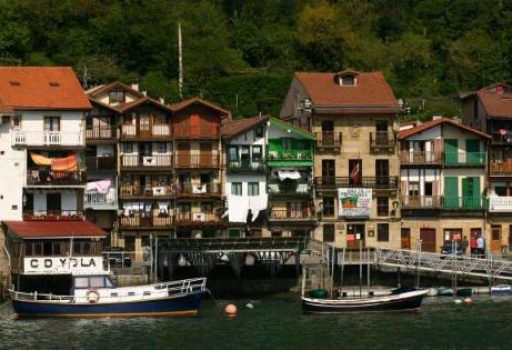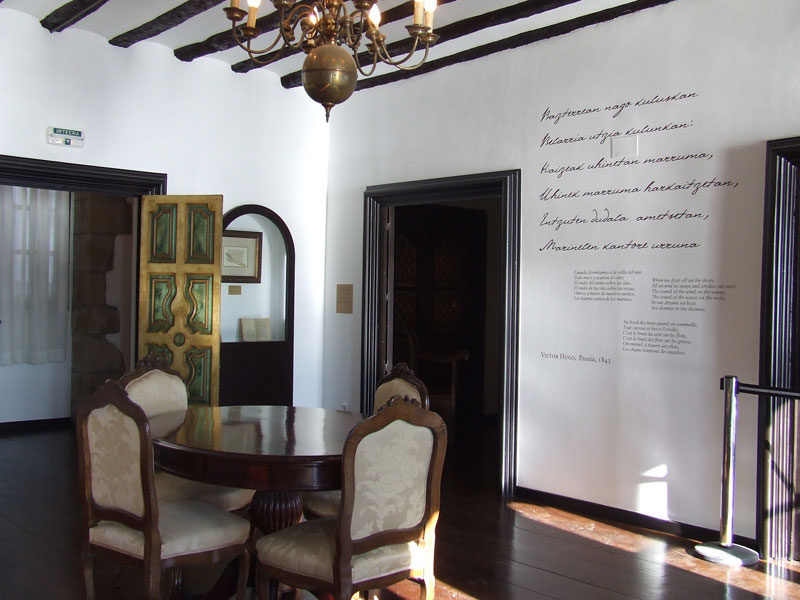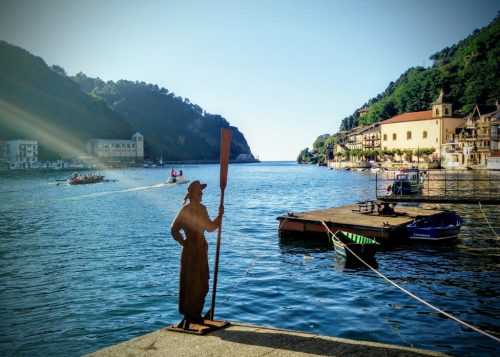Pasai Donibane

Very close to San Sebastian is the village of Pasajes, located in the bay of the same name. This bay, much more protected than that of La Concha in Donosti, thanks to its long mouth, contains other villages on its shores, and Pasajes itself is divided into 4 neighbourhoods that are considerably separated from each other. One of these neighbourhoods is Pasai Donibane (Pasajes San Juan).
Its streets, buildings and old town
In Pasai Donibane there are two clearly differentiated areas, the new and the old. The new one is not very interesting, they are residential buildings built during the 20th century to meet the demand of a growing population. But the old one… The old town is so beautiful that you won’t want to leave.
The old quarter of Donibane (or San Juan) is simply a narrow winding street called Donibane as well, running from the roundabout by the marina to the Basilica of Cristo de la Bonanza, practically the last building in the neighbourhood to the north. Coincidentally, one of the first is the Church of San Juan Bautista, patron saint, obviously, of the neighbourhood.
Remember that you can visit the eastern area of Guipuzkoa with Golocal through our excursions to Hondarribia and Pasaia.
This street is flanked almost all the time by houses on both sides, the ones next to the mountain and the ones next to the sea. Some are old fishermen’s houses, others spectacular baroque palaces. Some overlook the street creating passageways, others overlap the hillside where there is a gap. And the result is a charming place, full of history and places to photograph.

Arriving at the Plaza de Santiago. Photo by Felixsen on Wikiloc.
Two of these places are the openings from the street to the sea. One is the Humilladero de la Piedad, the other is the Plaza de Santiago. And perhaps the Plaza de Santiago is the best known spot in the whole of Pasai Donibane, as it is where we can find the typical fishermen’s houses with their colourfully painted balconies. It is also where many of the town’s bars and restaurants with their terraces are located, and the old town hall (now at the beginning of Donibane street, in the old 17th century Arizabalo palace).
Victor Hugo’s house
Also from the 17th century is what is known as Victor Hugo’s House. Nowadays used as a tourist office, it is so called because in 1843, the famous French writer stayed there for a few days, where he spent, wrote and drew. The house remains more or less as he knew it and you can visit it and admire the same views he enjoyed, albeit with some variations.

Interior of the House of Victor Hugo. Photo by Oarsoaldea Turismo.
Walk to Puntas
Although we have mentioned that one of the last buildings in the neighbourhood is the Basilica of Cristo de la Bonanza, the walk continues along the sea. Passing more recent houses, the arch of Bonanza and the castle of Santa Isabel, part of the old fortifications of the city, we reach almost the entrance to the mouth of Pasajes, or in other words, Puntas.
The walk is most pleasant, it is not very long or difficult, and has very good views on the other side of the mouth, with the San Pedro neighbourhood and its own promenade up to almost the entrance to the mouth. And almost at the end is the Alabortza canteen, a perfect place to have an aperitif, lunch or dinner. They grill sardines in the canteen during the summer and there are spectacular sunsets from the terrace.

The views from the Cantina de Alabortza. It is not paradise, but almost. Photo by Expansión.
Right next to it is the cove of the same name, a very pleasant place to have a swim on very hot days or simply enjoy the sea.
If you want to enjoy a different view, next to the cove you will see that the road goes uphill, if you follow it to the left you will reach a viewpoint from where you can see the mouth and the sea. It is worth coming here, especially when large cargo ships approach (the one carrying cars is spectacular to see).
How to get there from San Sebastian
Getting to Pasai Donibane from San Sebastian is very easy. You can come directly by car (the car park is very close to the roundabout mentioned above) or by bus. The E1 bus that leaves from Plaza Gipuzkoa arrives here and leaves every 20 minutes on weekdays, every 30 minutes on Sundays and public holidays.
In any case, we recommend coming by motorboat, as it is the most beautiful and fastest way to get to Donibane, and also the most used. To get there you have to go to Pasajes San Pedro, the district of Pasajes just opposite San Juan.
Getting to San Pedro is even easier than getting to San Juan, as you don’t have to go all the way around the bay. There is also where to leave the car, walking is about 1 hour from the centre of Donosti, half an hour by bike, and the E9 bus from Oquendo Street leaves every 15 minutes, 20 minutes on Sundays and public holidays.
The motorboat takes you from the Torreko Plaza pier, at the end of San Pedro and Arraunlari streets. It is a green and white motorboat that you pay for in cash on the spot (1.10€ for the ticket) and it takes 1 minute to cross the mouth of the sea to the San Juan pier, located next to the aforementioned Humilladero de la Piedad.
Unless you are terrified of the sea, although we can assure you that there is nothing dangerous about this mini-trip, it is the best way to get to Pasai Donibane and enjoy one of the most beautiful places in the Basque Country.
Related tours
